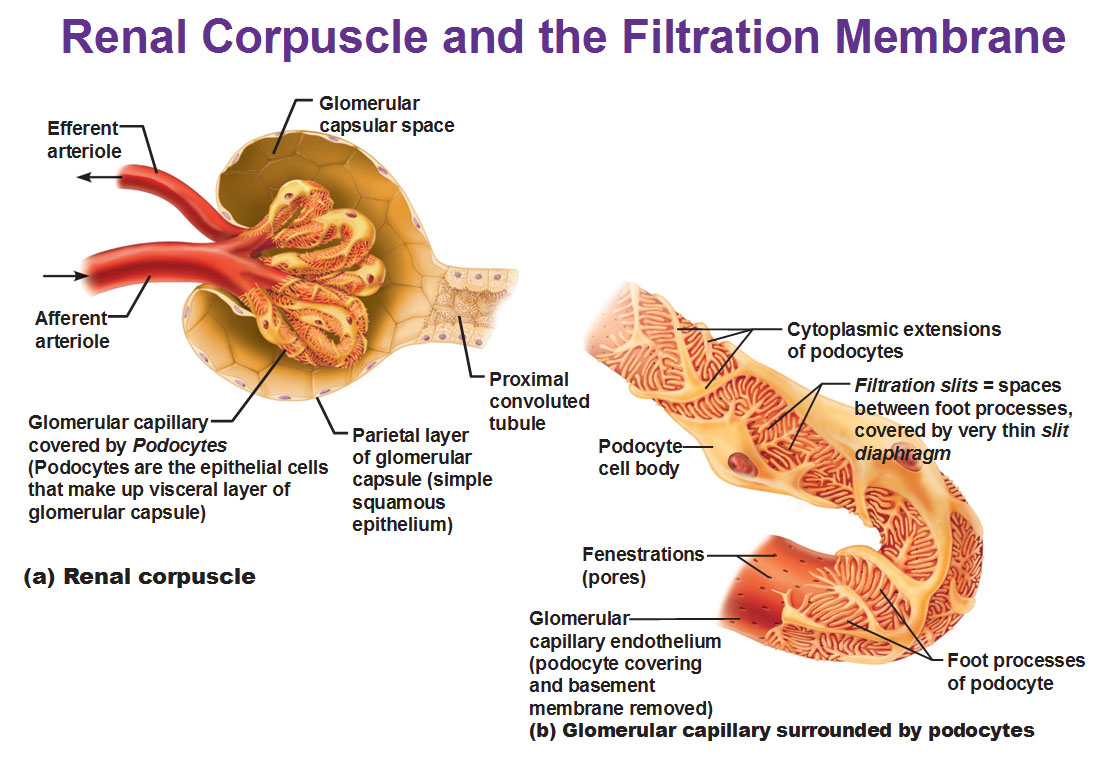Renal Corpuscle
A Renal Corpuscle is a kidney component that is an initial blood-filtering process.
- Example(s):
- Counter-Example(s):
- See: Urine, Kidney, Nephron, Bowman's Capsule, Fenestra (Histology), Mesangial Cell, Glomerular Basement Membrane, Podocyte, Heparan Sulfate, Glycosaminoglycan, Proximal Convoluted Tubule.
References
2017
- (Wikipedia, 2017) ⇒ https://en.wikipedia.org/wiki/renal_corpuscle Retrieved:2017-4-7.
- In the kidney, a renal corpuscle is the initial blood-filtering component of a nephron. It consists of two structures: a glomerulus and a Bowman's capsule.
The glomerulus is a small tuft of capillaries containing two cell types. Endothelial cells, which have large fenestrae, are not covered by diaphragms. Mesangial cells are modified smooth muscle cells that lie between the capillaries. They regulate blood flow by their contractile activity and secrete extracellular matrix, prostaglandins, and cytokines. Mesangial cells also have phagocytic activity, removing proteins and other molecules trapped in the glomerular basement membrane or filtration barrier.
The Bowman's capsule has an outer parietal layer composed of simple squamous epithelium. The visceral layer, composed of modified simple squamous epithelium, is lined by podocytes. Podocytes have foot processes, pedicels, that wrap around glomerular capillaries. These pedicels interdigitate with pedicels of adjacent podocytes forming filtration slits.
The renal corpuscle filtration barrier is composed of: the fenestrated endothelium of glomerular capillaries, the fused basal lamina of endothelial cells and podocytes, and the filtration slits of the podocytes. This barrier permits passage of water, ions, and small molecules from the bloodstream into Bowman's space (the space between the visceral and parietal layers). Large and/or negatively charged proteins are prevented from passing into Bowman's space, thus retaining these proteins in the circulation. The basal lamina is composed of 3 layers: lamina rara externa, lamina densa, and lamina rara interna. The lamina rara externa is adjacent to the podocyte processes. The lamina densa is the central layer consisting of type IV collagen and laminin. This layer acts as a selective macromolecular filter, preventing the passage of large protein molecules into Bowman's space. The lamina rara interna is adjacent to endothelial cells. This layer contains heparan sulfate, a negatively charged glycosaminoglycan that contributes to the electrostatic barrier of the glomerular filter.
There are two poles in the renal corpuscle, a vascular pole, and a urinary pole. The vascular pole is where the afferent and efferent arterioles communicate with the glomerulus. The urinary pole is where the corpuscle opens into the lumen of the proximal convoluted tubule.
Fluid from blood in the glomerulus is collected in the Bowman's capsule to form "glomerular filtrate", which is then further processed along the nephron to form urine.
The three types of filtration carried out in the Bowman's capsule are:
1) Basement Filtration
2) Visceral Filtration
3) Endothermic Filtration
- In the kidney, a renal corpuscle is the initial blood-filtering component of a nephron. It consists of two structures: a glomerulus and a Bowman's capsule.


